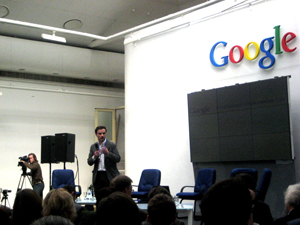21 Education Thesis 2.0
 Education 2.0: abstracts of the conference of the achievements of Google economy
Education 2.0: abstracts of the conference of the achievements of Google economyMarch 27, Moscow. Google held an expert round table and a conference for teachers and education professionals under the general title “Education 2.0”.
The conference began with an open discussion, which was attended by Dmitry Zimin (Dynasty Foundation), Olga Polyakova (Gymnasium 1518), Anna Zelentsova (International Business Leaders Forum), Ilya Shchurov (Computerra), Svetlana Konyushenko (I. Kant State University, Kaliningrad) and Dmitry Peskov (MGIMO). In addition, experts and representatives of the educational community of Russia who were present in the audience took an active part in the debates.
')
1. In the Internet era, there is no one who is smarter than everyone. The era of computers is over. Today not computers, but communications work. There was a network economy and network education.
2. The modern problem of education: education of human culture, education of the worldview. In our time, access to knowledge (via the Internet) has depreciated, but it does not help education. Suffering education worldview. The existing flow of information is “littered” and the person should be able to filter it and the teacher should teach it!
3. The availability of information on the Internet is good - but like any freebie it dilutes the brain. Perhaps the Internet is killing interest in learning? Information volumes have increased hundreds of times. It is possible to see all the chess games for the last hundred years, but this does not increase the number of grandmasters.
4. In the Internet era, you need to be a new type of teacher. Have new competencies. The teacher should be able to learn by himself, he should be able to transfer his language to the Internet. Critical thinking is the first thing that should be when entering a network. However, it should also have universal characteristics, regardless of time. Now we can not predict the future.
5. Education as a process: “training-upbringing-development” and nothing in it can replace live communication between teachers and students. When learning, each person can dominate different channels of perception. For the learning process to be effective it is necessary to use all the channels. Trainees take an example from the teacher and the Internet will not replace him.
6. Teachers who know information technologies at the user level come to schools. There is no visible barrier between teachers and students in possession of new technologies, but for teachers now is a big problem - to put all the necessary knowledge into the lesson with maximum efficiency. This is due to the acute demand for new educational technologies.
7. Information technologies solve many problems in the field of education, but they do not solve the problem of filling educational resources with high-quality content.
8. A lot of books on pedagogy and education are sold in bookstores, but there are no links to useful online resources. There is a lot of useful material for the teacher on the Internet, but he has no opportunity to search for him for hours.
9. Education in Russia is in crisis. A lot is said about those things that simply do not exist. The training of schoolchildren, applicants, students, teachers often decreases, simply not ready to work with children. An erroneous orientation is set for the transfer of knowledge, not for learning activities. We have a lot of computers, communications are actively developing, but we are still people of the 20th century, and in pedagogy are people of the 19th century.
10. We talk a lot about modern equipment, new technologies, but often began to forget about the people who need to use this equipment and use it in their practice.
11. The main goal in education is the development of an intellectual in any profession. Classical pedagogy is “childbirth”. We are all teachers, someone is doing it professionally, and someone is just at home with their children.
12. Content filtering in educational institutions does not solve the problem. Anyone who wants in any case will find the opportunity to see negative content. It is necessary to filter for the whole society.
13. The flow of information grows and it becomes a new factor of production. What is the place of the teacher and the student in these streams?
14. Modern technologies in a different way build organizational forms of communication. Lined up not vertical, but horizontal links. In these connections - the stronger the authority of the teacher as a person - the more it will attract students. The students' self-esteem increases when the teacher says, “let's do it together.” In Wikipedia, the article can be edited by the Losers and Professor - and this scheme works successfully. In the network all are at the same board.
15. Students come to the Internet, because there is a “fast life”.
16. In the era of education 2.0, ordinary universities should be transformed into “student corporations”. Inside of them must be created a new type of community.
17. Current requirements of employers for graduates: the ability to analyze information, project thinking, teamwork. These are the needs of the new economy, but the existing education system does not support real processes in the economy. In addition, it does not teach to adapt to life.
18. Web 2.0 is knocking on education, but it does not open.
19. The most important thing is not the volume of knowledge, but the speed of change.
20. Developers of modern educational technologies offer teachers beautiful toys, but teachers themselves are not involved in their development and as a result, these toys do not take root in the educational process.
21. The family left the education process. Children go online, feeling a lack of communication in the family.
R.A. Dorofeev, faito.ru
Source: https://habr.com/ru/post/22502/
All Articles